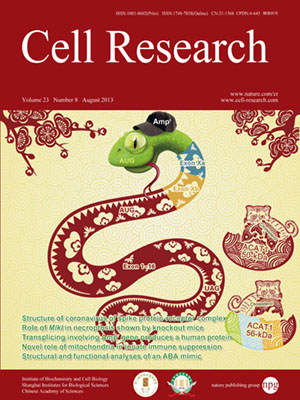
Volume 23, No 8, Aug 2013
ISSN: 1001-0602
EISSN: 1748-7838 2018
impact factor 17.848*
(Clarivate Analytics, 2019)
Volume 23 Issue 8, August 2013: 1059-1062
LETTERS TO THE EDITOR
Generation of RAG 1- and 2-deficient rabbits by embryo microinjection of TALENs
Jun Song1,*, Juan Zhong1,*, Xiaogang Guo1,*, Yongqiang Chen1,3, Qingjian Zou1,3, Jiao Huang1, Xiaoping Li2, Quanjun Zhang1, Zhiwu Jiang1, Chengcheng Tang2, Huaqiang Yang1, Tao Liu1, Peng Li1, Duanqing Pei1 and Liangxue Lai1,2
1Key Laboratory of Regenerative Biology, Chinese Academy of Sciences, Guangdong Provincial Key Laboratory of Stem Cells and Regenerative Medicine, South China Institute for Stem Cell Biology and Regenerative Medicine, Guangzhou Institutes of Biomedicine and Health, Guangzhou, Guangdong 510530 China
2College of Veterinary Medicine, Jilin University, Changchun, Jilin 130062 China
3School of Life Sciences, University of Science and Technology of China, Hefei Anhui 230027 China
Correspondence: Duanqing Pei, E-mail: pei_duanqing@gibh.ac.cn; Liangxue Lai, E-mail: lai_liangxue@gibh.ac.cn*These three authors contributed equally to this work.
The traditional approach for the generation of gene-targeted animals is homologous recombination (HR) conducted in embryonic stem (ES) cells followed by chimera technology, such as in mice and rats, or HR in somatic cells combined with nuclear transfer in those animals in which germline-competent ES cells are not available, such as pigs, sheep, goats, and cattle. However, no germline-competent rabbit ES cells are yet available. Furthermore, the efficiency of rabbit cloning is so low that no gene-targeted rabbits have been produced thus far by somatic cell nuclear transfer approaches. Over the past several years, zinc-finger nucleases (ZFNs) technology has been employed to produce gene knockout (KO) animals, such as rats1, pigs2, and rabbits3. Recently, transcription activator-like effector nucleases (TALENs), a new genome-modifying technology, has been employed for in vivo genetic engineering in vertebrates. Unlike ZFNs, TALENs have fewer off-target effects and lower toxicity. Given the success of the TALEN technology in reported species 4,5,6, we attempted to explore the feasibility of producing KO rabbits using this technology. In the current study, we chose recombination activation genes (RAGs), including RAG1 and RAG2, as the first genes of interest. RAG gene product have a crucial function as enzymes that activate or catalyze the V(D)J recombination reaction in primary lymphoid tissues. RAG gene-targeted mice without mature B and T cells are powerful tools for studies of allografts, xenografts, tumors, vaccine development, and infectious diseases7,8. Owing to their suitable size and similar physiology to humans, RAG-deficient rabbits would be valuable models in biomedicine research.
10.1038/cr.2013.85
FULL TEXT | PDF
Browse 2867


